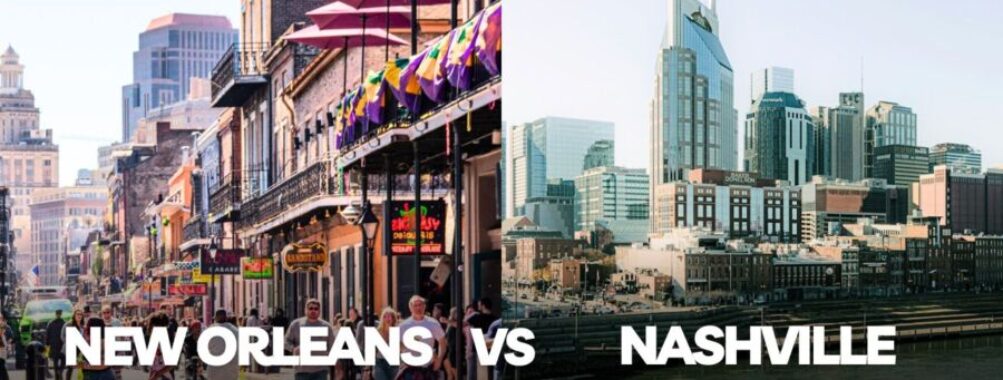
New Orleans vs Nashville: 7 Key Differences to Know Before Your 2025 Southern Adventure
Planning a trip to the South? Nashville and New Orleans offer two completely different experiences that might leave you wondering which deserves your vacation days.
New Orleans stands out for its unique food culture, walkable neighborhoods, rich history, and distinct atmosphere, while Nashville shines with its booming growth, music scene, and impressive museums. Both cities feature touristy areas that draw crowds, but they hide authentic neighborhoods waiting to be explored by travelers willing to venture beyond the main attractions.
Weather plays a role in your decision, too. New Orleans faces challenges like flooding and hurricanes, especially in low-lying areas. Meanwhile, Nashville continues to expand rapidly as one of the South’s fastest-growing cities.
Your perfect choice depends on whether you prefer Nashville’s modern energy or New Orleans’ historic charm—and how much time you have. A quick weekend might work better for New Orleans, while Nashville rewards a longer stay.
Contents
- Historical Context
- Evolution of New Orleans
- Development of Nashville
- Geographical Overview
- New Orleans’ Positioning
- Nashville’s Location
- Cultural Insights
- New Orleans’ Diverse Culture
- Nashville’s Musical Roots
- Musical Landscapes
- New Orleans: Jazz and More
- Nashville: Country Music Capital
- Culinary Face-Off
- Savoring New Orleans
- Tasting Nashville
- Architectural Contrast
- New Orleans’ Architecture
- Nashville’s Building Styles
- Natural Surroundings
- Exploring the Outdoors in New Orleans
- Nashville’s Scenic Routes
- Festive Celebrations
- New Orleans’ Year-round Festivities
- Nashville’s Musical Events
- Visiting in September
- Frequently Asked Questions
- What are the top tourist attractions when comparing a vacation in New Orleans to Nashville?
- Which city offers a better experience for a bachelor party, New Orleans or Nashville, and what unique activities does each provide?
- When planning a trip, what factors should be considered to determine the optimal duration of stay in Nashville?
- Beyond touristic sights, what cultural and local lifestyle aspects set New Orleans apart from Nashville?
- Can visitors expect a significant difference in living expenses and safety when choosing between New Orleans and Nashville for relocation?
- What are the best periods of the year to explore each city’s music and festival scenes, and how do these seasons impact travel planning?
- More Travel Guides
Historical Context
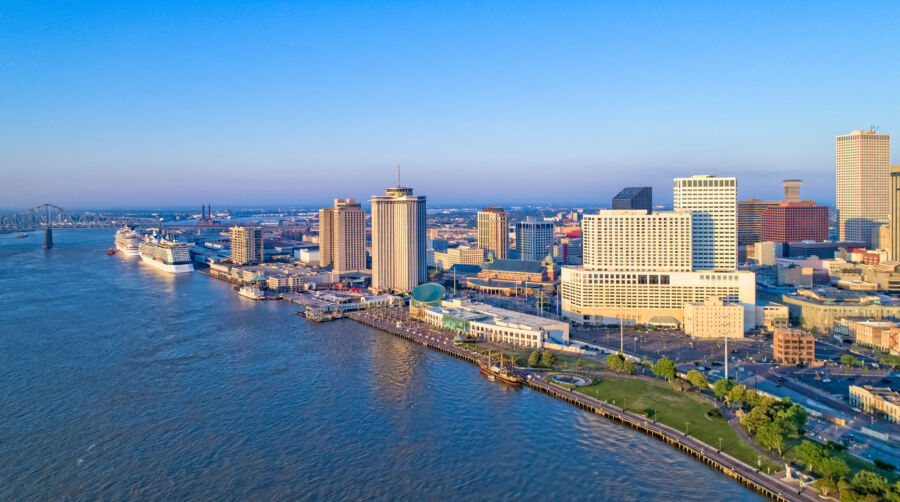
New Orleans and Nashville have fascinating histories shaping their unique cultural identities. Their different geographical locations and historical influences contributed significantly to how these cities developed their distinctive characters, music scenes, and atmospheres.
Evolution of New Orleans
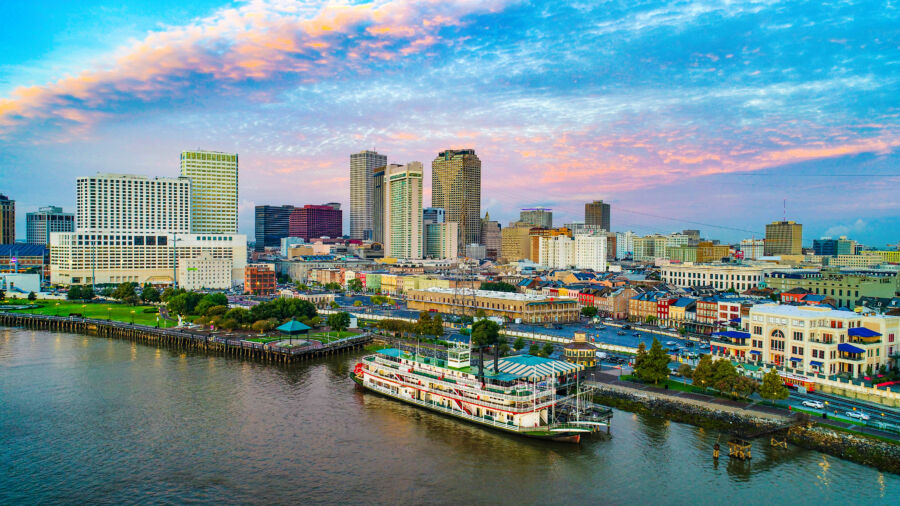
New Orleans was founded in 1718 by French colonists and named after the Duke of Orleans. Subsequent waves of French, Spanish, and American rule influenced the city’s unique history.
The port city became a melting pot of cultures unlike elsewhere in America. African, Caribbean, French, Spanish, and Creole influences blended to create New Orleans’ distinctive character.
In the 19th century, New Orleans emerged as a major trading hub due to its strategic location near the Mississippi River delta. This commercial importance brought wealth and diverse cultural influences to the city.
The birth of jazz in New Orleans around the early 1900s cemented the city’s musical legacy. Musicians like Louis Armstrong helped define this uniquely American art form, which was born from the city’s multicultural roots.
Hurricane Katrina 2005 marked a tragic chapter in the city’s history, but New Orleans has shown remarkable resilience. The rebuilding efforts have honored traditions while embracing necessary changes.
Development of Nashville

Nashville was founded in 1779 as Fort Nashborough, named after American Revolutionary War hero Francis Nash. The settlement grew slowly but steadily along the Cumberland River.
The city earned its nickname “Athens of the South” in the 19th century due to its focus on education and the arts. This included the establishment of several colleges and the construction of a full-scale replica of the Parthenon.
Nashville’s transformation into “Music City” began in the 1920s with the launch of the Grand Ole Opry radio show. This weekly country music broadcast helped establish Nashville as the center of country music production.
The 1950s and 60s saw the development of “Music Row,” where major record labels, studios, and publishing houses concentrated. This solidified Nashville’s place in the music industry beyond just country music.
In recent decades, Nashville has experienced tremendous economic growth and diversification. While maintaining its musical heritage, the city has expanded into the healthcare, education, and technology sectors.
Geographical Overview

When comparing New Orleans and Nashville, their geographical differences shape each city’s character and lifestyle. These two Southern cities occupy distinct landscapes, with varying elevations, sizes, and natural surroundings that influence everything from climate to urban development.
New Orleans’ Positioning

New Orleans is located in southeastern Louisiana near the Gulf of Mexico, giving it a unique coastal influence. The city covers approximately 180.6 square miles, making it significantly smaller in land area than Nashville. Much of New Orleans is below sea level, which explains its vulnerability to flooding and hurricane damage.
The city’s location at the mouth of the Mississippi River has historically made it an important port city. This positioning has shaped its economy and culture over centuries. Water defines New Orleans, with Lake Pontchartrain to the north and the winding Mississippi River creating the city’s distinctive crescent shape.
The low elevation poses ongoing challenges for New Orleans, especially with climate change concerns. This geographical reality requires extensive levee systems and pumps to manage water during storms and heavy rainfall.
Nashville’s Location

Nashville occupies a prime spot in north-central Tennessee along the Cumberland River. The city sits about 550 feet above sea level, providing natural protection from flooding compared to New Orleans. Nashville boasts an impressive land mass of over 500 square miles, making it the second-largest U.S. city by land area.
The city’s central location connects it to several major highways. I-65 runs through Nashville, linking it to Birmingham to the south and Kentucky to the north. The historic Natchez Trace Parkway also begins in Nashville, offering a scenic route southwest.
Nashville’s rolling hills and plateaus create a varied landscape that differs dramatically from New Orleans’ flatness. Unlike New Orleans, the Cumberland River winds through the city, but water doesn’t define Nashville’s existence. The higher elevation also contributes to Nashville’s four distinct seasons, while New Orleans experiences a more consistently warm climate.
Cultural Insights
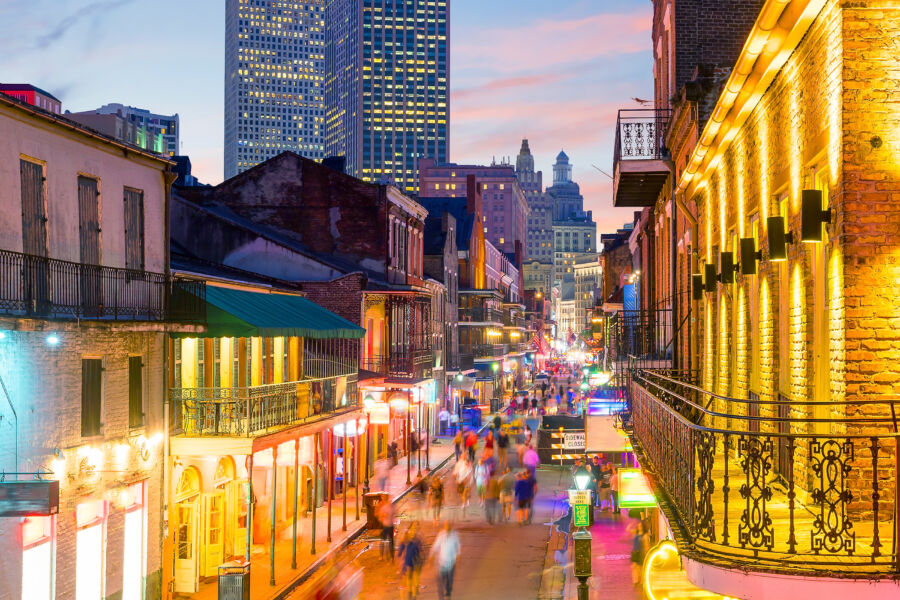
Both Nashville and New Orleans offer distinct cultural experiences that shape their identities. These cities represent different facets of American heritage, with unique traditions, music scenes, and social atmospheres that make each destination special.
New Orleans’ Diverse Culture
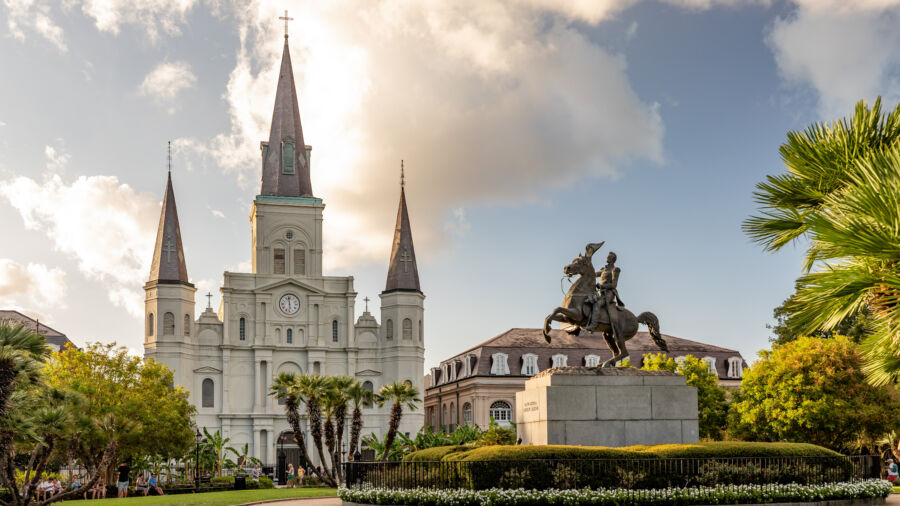
New Orleans stands out for its incredible cultural mix. The city blends African, French, Spanish, and Caribbean influences to create something truly unique. This non-conformist city embraces diversity in ways Nashville doesn’t quite match.
The famous French Quarter showcases the city’s rich history, distinctive architecture, and lively atmosphere. Beyond tourist spots, New Orleans offers authentic cultural experiences through its traditions, such as second-line parades and jazz funerals.
Cajun and Creole food reflects this cultural fusion. Gumbo, jambalaya, and beignets tell the story of the city’s diverse heritage through flavor. Food isn’t just sustenance here—it’s a celebration.
The spiritual side of New Orleans adds another fascinating layer. Visitors can explore voodoo traditions at the Historic Voodoo Museum or join walking tours that explain these practices. Cemeteries with their above-ground tombs have become cultural landmarks themselves.
Nashville’s Musical Roots

Nashville has earned its “Music City” nickname, honestly. While less diverse than New Orleans, Nashville’s musical heritage runs deep, centered particularly around country music. The Grand Ole Opry and Country Music Hall of Fame showcase this rich history.
The city tends toward conformity compared to New Orleans’ free spirit. Nashville’s culture feels more homogeneous but deeply authentic within its musical identity. Songwriters and musicians flock here, creating a community where music is both business and passion.
Beyond country, Nashville embraces other genres while maintaining its distinct character. The musical atmosphere extends to local restaurants, bars, and shops where live performances happen constantly.
While less distinctive than New Orleans’, Nashville’s food scene offers excellent Southern comfort dishes. Hot chicken has become the city’s signature dish, with places like Hattie B’s drawing food enthusiasts from everywhere. The city balances its traditional roots with modern development, creating a culture that feels both familiar and evolving.
See Related: New Orleans vs Savannah: Key Differences for Southern Charm Seekers
Musical Landscapes

New Orleans and Nashville are musical giants in America, each with its distinct sound and heritage. These cities have shaped entire genres of music that continue to influence artists worldwide.
New Orleans: Jazz and More

New Orleans birthed jazz, a uniquely American art form built on improvisation and creative expression. The city’s musical identity draws from a rich cultural gumbo of African, Caribbean, and European influences. Unlike Nashville’s more structured approach, New Orleans musicians blend genres freely and focus heavily on rhythm.
Brass bands remain a defining feature of New Orleans’ music scene, parading through streets during celebrations and funerals. The city’s musical heritage extends beyond jazz to include funk, R&B, zydeco, and bounce music.
Local venues like Preservation Hall offer authentic jazz experiences, while the annual Jazz & Heritage Festival showcases the city’s diverse sounds. New Orleans musicians emphasize collective improvisation and audience participation, creating an immersive musical experience.
Nashville: Country Music Capital

Nashville earned its “Music City” nickname through its deep connection to country music. The Grand Ole Opry, established in 1925, helped cement Nashville’s reputation as the genre’s epicenter. Unlike New Orleans’ emphasis on improvisation, Nashville’s music industry often relies on carefully crafted formulas and studio precision.
The city’s famous Music Row houses countless recording studios and music businesses, creating a professional ecosystem that attracts songwriters and musicians from around the world. Nashville’s sound has evolved from traditional country to include pop-country crossovers and Americana.
Beyond country music, Nashville hosts a growing indie rock scene and diverse musical offerings. The city’s songwriter culture stands out, with venues like the Bluebird Cafe featuring intimate performances where artists share the stories behind their songs.
Culinary Face-Off
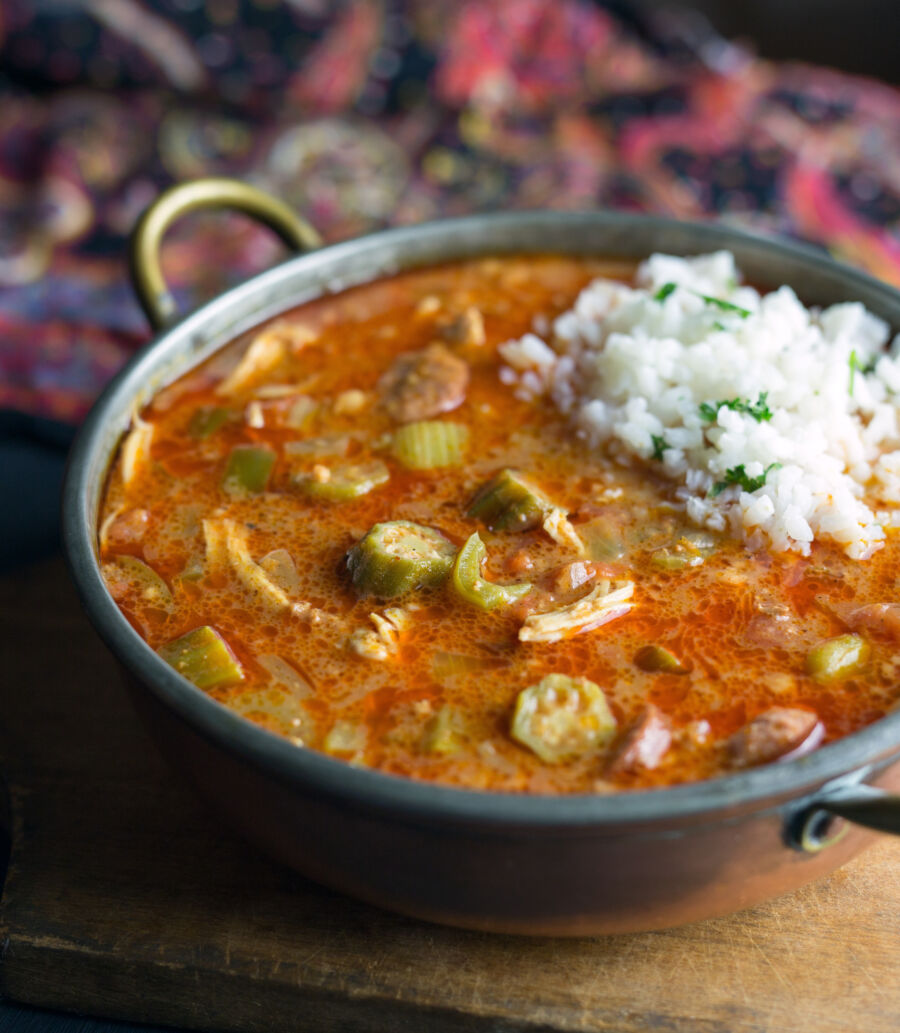
Both cities boast incredible food scenes that reflect their unique cultural heritage and regional influences. The battle between Nashville and New Orleans kitchens reveals distinct flavors, cooking techniques, and dining experiences that make each city a foodie paradise.
Savoring New Orleans

Regarding distinctive cuisine, New Orleans stands in a league of its own. The Crescent City serves a tasty blend of French, Spanish, African, and Caribbean influences you won’t find anywhere else.
Creole and Cajun dishes dominate the scene – think gumbo thick with okra, seafood jambalaya, and étouffée smothered in rich sauce. Po’boy sandwiches stuffed with fried seafood or roast beef “dressed” with lettuce, tomato, mayo, and pickles make for perfect lunch fare.
Beignets covered in powdered sugar paired with chicory coffee at Café du Monde is practically a required experience. And don’t miss out on crawfish boils during the season – locals will tell you the best way to “pinch the tail and suck the head.” The city’s cocktail culture also shines with classics like the Sazerac, Hurricane, and Ramos Gin Fizz originating in NOLA’s historic bars.
Tasting Nashville

In recent years, Nashville’s food scene has exploded beyond its famous hot chicken. This spicy dish – chicken fried and coated in cayenne pepper – ranges from mild to tongue-numbing at spots like Prince’s and Hattie B’s.
BBQ rules in Music City include smoky pulled pork, ribs, and brisket taking center stage. Meat-and-three restaurants (where you pick one meat and three sides) offer pure Southern comfort with favorites like country ham, cornbread, and mac and cheese.
Nashville’s breakfast game is strong, too. Fluffy biscuits smothered in sausage gravy are must-tries at local diners and cafes throughout the city.
The drink scene features craft whiskey cocktails and local brews in honky-tonks along Broadway. Many restaurants showcase farm-to-table cooking, highlighting Tennessee’s agricultural bounty with creative Southern twists.
Don’t leave without trying a Goo Goo Cluster—Nashville’s original candy, which combines caramel, marshmallow nougat, peanuts, and milk chocolate.
Architectural Contrast

The visual identity of New Orleans and Nashville tells two very different stories through their buildings and streetscapes. Each city showcases unique architectural styles that reflect their distinct histories, cultural influences, and relationship with their surroundings.
New Orleans’ Architecture
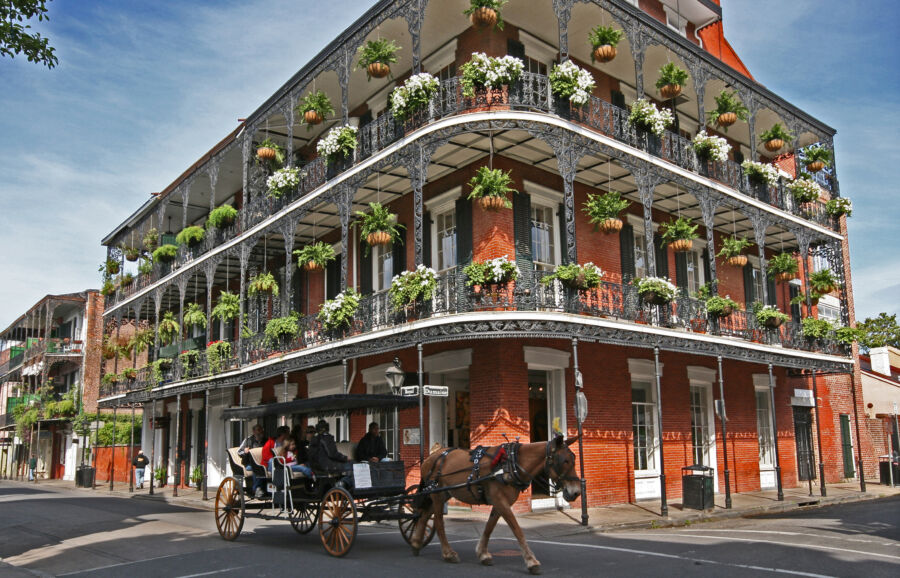
New Orleans boasts some of America’s most distinctive architecture, heavily influenced by French, Spanish, and Caribbean styles. The famous French Quarter features colorful Creole townhouses with wrought-iron balconies and hidden courtyards that transport visitors to another era.
The Garden District showcases magnificent Greek Revival and Victorian mansions with sprawling verandas. Many homes are slightly elevated, a practical response to the city’s flood-prone geography.
Shotgun houses, narrow rectangular homes perfect for natural cross-ventilation in the humid climate, line many residential streets. These practical designs showcase New Orleans’ adaptation to its environment.
The city’s architecture tells the story of its multicultural past through details like second-floor galleries, decorative ironwork, and vibrant color schemes. Historic preservation efforts have maintained these architectural treasures despite threats from hurricanes and flooding.
Nashville’s Building Styles

In recent years, Nashville’s architectural identity has evolved dramatically with its booming growth. The city combines traditional Southern styles with modern urban development, creating an interesting architectural mix.
Historic neighborhoods like Germantown feature Victorian-era homes and Federal-style buildings that recall Nashville’s earlier days. Downtown’s Broadway area maintains some classic brick structures alongside newer developments.
The “Batman Building” (AT&T Tower) has become Nashville’s skyline icon with distinctive spires. Recent construction has added sleek glass-and-steel high-rises, reflecting the city’s economic boom and growing status.
Unlike New Orleans’ preservation-focused approach, Nashville has embraced architectural reinvention. New construction dominates many areas, with luxury developments and modern condos reshaping neighborhoods. The Gulch district exemplifies this transformation, featuring contemporary urban design principles with mixed-use developments that contrast sharply with New Orleans’ centuries-old aesthetic.
See Related: New Orleans Trip Cost: Affordable 3-Day Jazz & Cuisine Adventure
Natural Surroundings

Both New Orleans and Nashville offer unique outdoor landscapes that showcase the natural beauty of their regions. While they differ greatly in topography, each city offers visitors distinctive outdoor experiences worth exploring.
Exploring the Outdoors in New Orleans
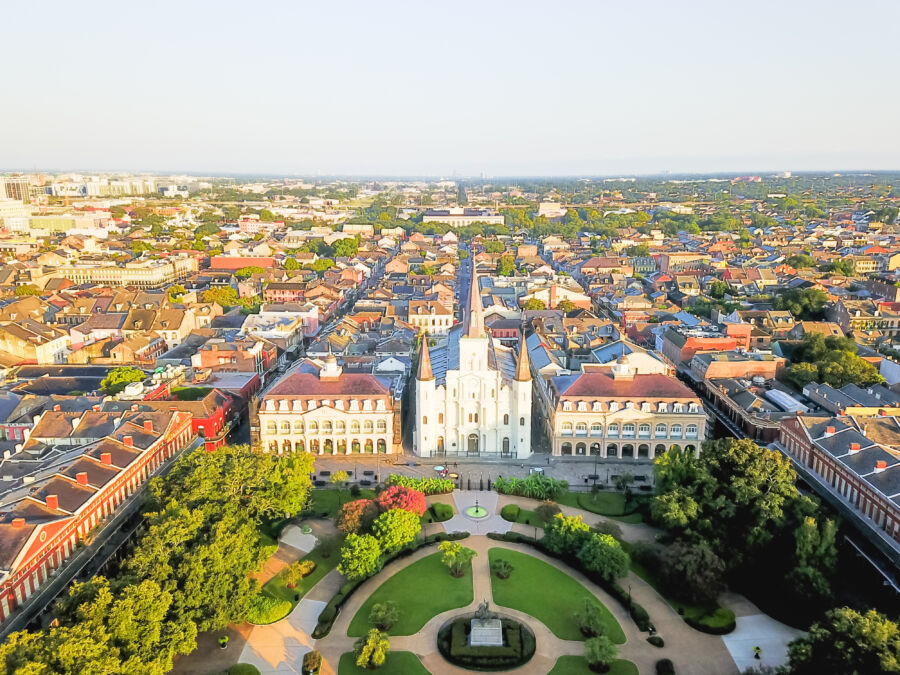
New Orleans is nestled between Lake Pontchartrain and the Mississippi River in a unique ecosystem where swamps, bayous, and marshlands create a mysterious natural backdrop. The city offers water-based outdoor activities year-round.
Visitors can explore the famous bayous on guided swamp tours outside the city. These tours provide close encounters with alligators, herons, and other wildlife in their natural habitat. The humidity creates a lush environment where Spanish moss drapes from cypress trees, creating an almost magical atmosphere.
Jean Lafitte National Historical Park and Preserve offers six sites around New Orleans, including the Barataria Preserve, with boardwalk trails through wetlands. City Park provides 1,300 acres of oak trees, lagoons, and gardens right in New Orleans for those who don’t want to venture far.
Nashville’s Scenic Routes
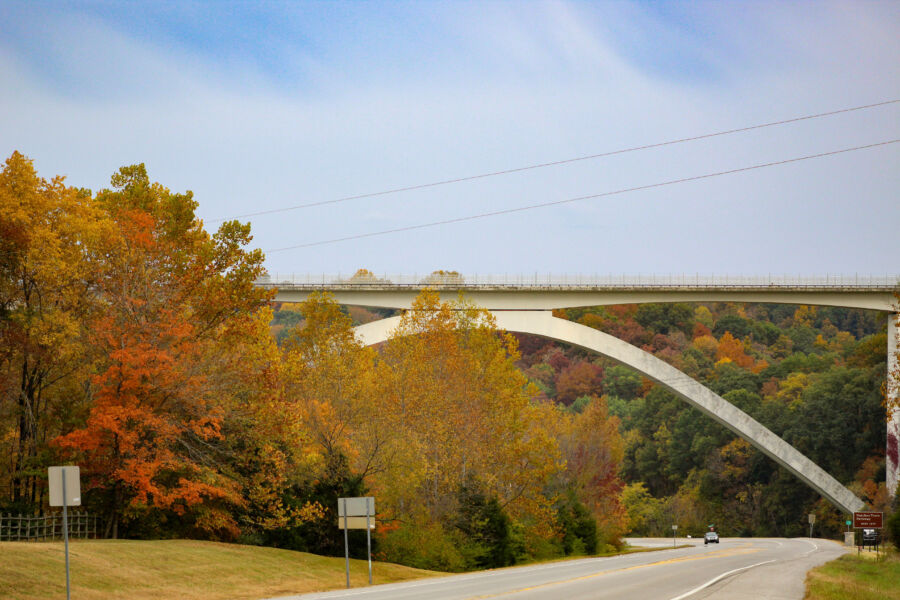
Nashville boasts a surprisingly diverse landscape, with rolling hills, forests, and the winding Cumberland River cutting through the city’s heart. The surrounding terrain offers many opportunities for hiking, cycling, and scenic drives.
The famous Natchez Trace Parkway begins in Nashville and provides a 444-mile scenic route that follows historic Native American trails. This beautiful drive features numerous overlooks, hiking trails, and historic sites where travelers can simultaneously connect with nature and history.
Percy and Edwin Warner Parks, collectively known as “The Warner Parks,” offer over 3,100 acres of forest with 9+ miles of hiking trails and scenic overlooks. Radnor Lake State Park, just 15 minutes from downtown, provides serene walking paths around a protected lake where deer and birds are commonly spotted.
Nashville’s hilly topography creates dramatic vistas and varied terrain that changes beautifully with the seasons. The Cumberland River also offers kayaking and paddleboarding opportunities for water enthusiasts.
Festive Celebrations

Both cities offer incredible festivals that showcase their unique cultural identities. New Orleans embraces celebration year-round with its famous Mardi Gras and other cultural events, while Nashville focuses on musical gatherings that highlight its status as Music City.
New Orleans’ Year-round Festivities
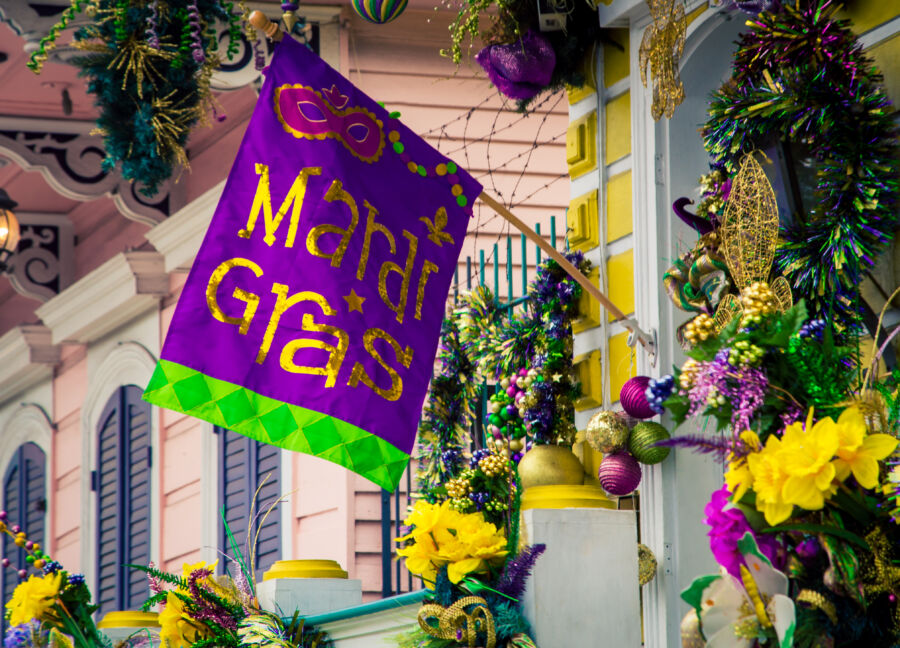
New Orleans truly earns its reputation as America’s festival capital. The city hosts over 130 festivals annually, with something happening almost every weekend.
Mardi Gras is the crown jewel, transforming the city into a vibrant celebration of parades, costumes, and traditions each February. The beads, floats, and king cakes create an atmosphere unlike anywhere else.
Christmas in New Orleans offers a magical experience, too. Christmas in the Oaks at City Park transforms the area with dazzling light displays, while downtown hotel lobbies showcase stunning decorations worth touring.
Jazz Fest in late April/early May brings world-class musicians to celebrate the city’s musical heritage. And for those visiting in September, Southern Decadence and the Burlesque Festival showcase the city’s open-minded spirit.
Nashville’s Musical Events

Nashville’s festival scene revolves around its musical identity, with events that showcase everything from country to rock to bluegrass. CMA Fest in June stands as Nashville’s signature event, drawing country music fans from around the world. The four-day festival features hundreds of artists performing across multiple venues throughout the city.
For rock fans, September brings the Americanafest, celebrating roots, folk, and alternative country music with performances in venues across town. The Nashville Film Festival includes impressive music documentaries and live performances that capture the city’s creative spirit. Meanwhile, winter visitors can enjoy Nashville’s Christmas parade and the Opryland Hotel’s spectacular holiday light display.
Visiting in September
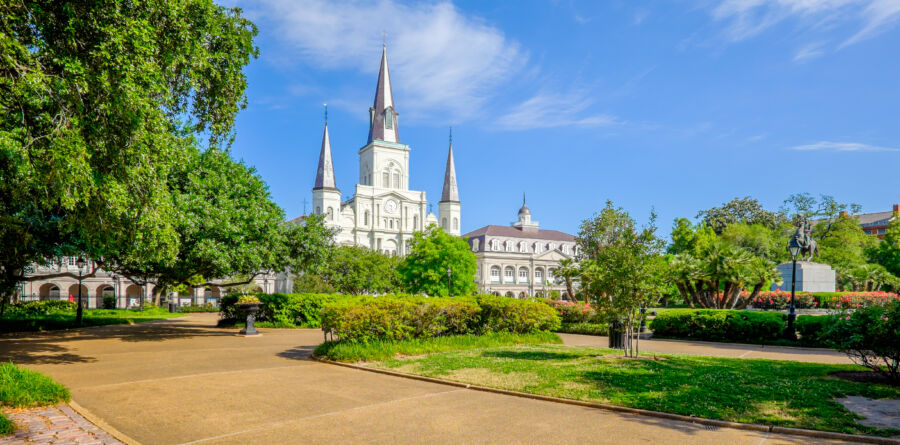
September is a transitional month for both Nashville and New Orleans, offering unique experiences in each city. The weather begins to cool down, making it more comfortable for exploring.
In Nashville, September temperatures typically range from 65-85°F. The summer crowds start to thin out, giving you more space to enjoy popular attractions. Music venues are less packed, and you might snag tickets to shows that would be sold out during peak season.
September in New Orleans remains warm and humid, with temperatures between 70-90°F. This month, the city sees fewer tourists, meaning shorter lines at famous restaurants and more affordable hotel rates. Hurricane season is still in effect, so it’s wise to watch weather forecasts.
Both cities host special events in September. Nashville celebrates the Americana Music Festival, bringing together musicians nationwide. New Orleans offers the Southern Decadence Festival and various food events showcasing local cuisine.
Budget-conscious travelers will appreciate September pricing in both destinations:
| City | Hotel Rates | Crowd Levels | Weather |
|---|---|---|---|
| Nashville | Lower than summer | Moderate | Mild to warm |
| New Orleans | Significantly discounted | Low | Warm and humid |
The locals in both cities often say September gives visitors a more authentic experience without the overwhelming tourist presence of peak seasons.
See Related: Most Breathtaking Places to Visit in the World (Travel Guide)
Frequently Asked Questions

When comparing New Orleans and Nashville as vacation or relocation destinations, travelers often have specific questions. Both cities offer unique experiences with distinct music scenes, food cultures, and lifestyle considerations.
What are the top tourist attractions when comparing a vacation in New Orleans to Nashville?
New Orleans boasts the historic French Quarter with its iconic Bourbon Street, Jackson Square, and St. Louis Cathedral. The Garden District offers beautiful historic homes and Lafayette Cemetery.
Music lovers should visit Frenchmen Street for authentic jazz and Preservation Hall for traditional performances. Don’t miss the National WWII Museum or a steamboat cruise on the Mississippi River.
Nashville centers around its country music heritage with must-visit attractions like the Grand Ole Opry, the Country Music Hall of Fame, and the historic Ryman Auditorium. The Parthenon in Centennial Park is a full-scale replica of the original Greek structure.
Broadway’s honky-tonk district offers live music venues, while the Johnny Cash Museum and Musicians Hall of Fame celebrate diverse musical legacies. For something different, check out the art scene at the Frist Art Museum.
Which city offers a better experience for a bachelor party, New Orleans or Nashville, and what unique activities does each provide?
New Orleans excels for bachelor parties seeking a lively, anything-goes atmosphere. The city’s liberal open container laws allow walking between venues with drinks in hand, especially along Bourbon Street.
NOLA offers unique experiences like swamp tours, ghost tours, gambling at Harrah’s Casino, and world-class dining. The city’s 24-hour bars and vibrant nightlife create an unforgettable celebration atmosphere.
Nashville has become increasingly popular for bachelor parties due to its growing brewery scene, pedal taverns, and party barges on the Cumberland River. The city also offers excellent golfing, axe-throwing venues, and Nashville Predators hockey games.
Music lovers appreciate Nashville’s songwriter nights, studio tours, and honky-tonk hopping on Broadway. Nashville attracts crowds seeking a slightly more structured and music-focused celebration than New Orleans’ freewheeling vibe.
When planning a trip, what factors should be considered to determine the optimal duration of stay in Nashville?
A three-day weekend for first-time visitors focused on music attractions can adequately cover most Nashville highlights. This allows time to explore Broadway and major museums and catch a few performances.
Five days in Nashville provides a more comprehensive experience, allowing visitors to venture beyond tourist areas into neighborhoods like East Nashville, 12 South, and The Gulch. This longer duration lets you explore the food scene, take day trips, and avoid rushing.
Consider planning around special events like CMA Fest, Americana Music Festival, or Nashville Film Festival, which might warrant extended stays. Nashville’s compact downtown means major attractions are accessible, but transportation time increases when exploring outlying areas.
Your interest in specific music genres may influence stay duration. Country music enthusiasts might need extra days to fully experience the Grand Ole Opry, backstage tours, and multiple honky-tonks.
Beyond touristic sights, what cultural and local lifestyle aspects set New Orleans apart from Nashville?
New Orleans embraces a distinctive “laissez-faire” attitude with a pace that feels remarkably different from most American cities. The city’s unique Creole and Cajun heritage infuses everything from language to architecture.
NOLA’s neighborhood culture revolves around community events like second-line parades, social aid, and pleasure clubs. Local traditions such as Mardi Gras Indians and jazz funerals represent cultural practices found nowhere else in America.
Nashville has a more traditional Southern character with a modern cosmopolitan overlay. The city maintains strong connections to its country music roots while embracing new industries and rapid growth.
Nashville’s lifestyle centers more around outdoor activities, with numerous parks, greenways, and the nearby Percy Priest Lake. The city’s religious heritage remains visible through its numerous churches and Christian music industry presence.
Can visitors expect a significant difference in living expenses and safety when choosing between New Orleans and Nashville for relocation?
According to search results, Nashville offers slightly lower average rent (over $100 less monthly) than New Orleans. Nashville housing typically features newer construction with better energy efficiency, potentially reducing utility costs.
New Orleans properties often have character and history but may require more maintenance due to age, humidity, and weather concerns. Both cities have experienced rising housing costs as their popularity increases.
Safety considerations differ between the cities. New Orleans continues to face higher crime rates in certain neighborhoods, while Nashville has better crime statistics overall. Both cities require area-specific research before relocation.
Both destinations have distinct transportation challenges. New Orleans offers better public transit options but risks flooding during heavy rains. Nashville has limited public transportation but better highway infrastructure.
What are the best periods of the year to explore each city’s music and festival scenes, and how do these seasons impact travel planning?
New Orleans shines during winter and spring (January-May) when temperatures are mild and major festivals occur. Mardi Gras (February/March) and Jazz Fest (late April/early May) showcase the city’s music and culture at their peak.
Fall brings comfortable temperatures and events like the Voodoo Music Festival and the Oak Street Po-Boy Festival. Summer months (June-August) offer lower hotel rates but oppressive heat, humidity, and hurricane season concerns.
Nashville’s prime festival season runs from April through October. Major events include CMA Fest (June), Americana Fest (September), and numerous summer outdoor concert series. Spring brings comfortable temperatures and blooming scenery around the city.
Winter in Nashville (December-February) offers fewer outdoor music options but provides easier venue access and lower accommodation rates. The Christmas season features special Grand Ole Opry and Ryman Auditorium performances.



